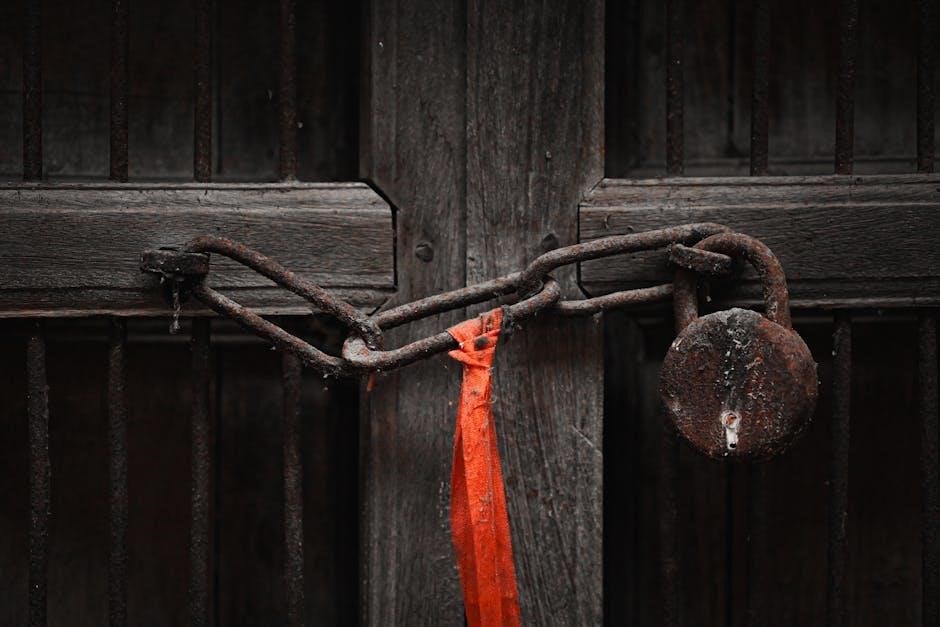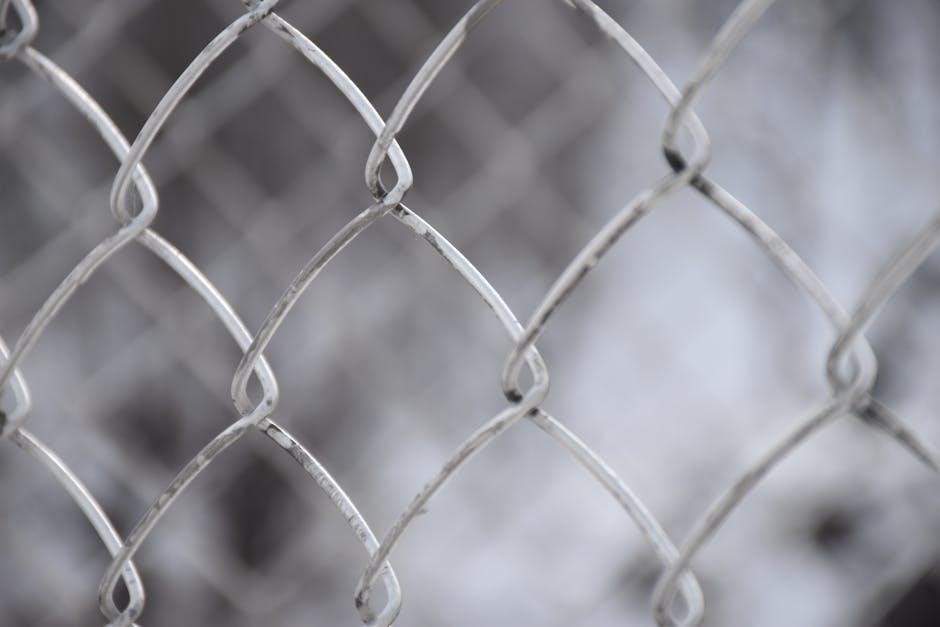
A chain guide bash guard is a crucial component for mountain bikes, designed to protect the chain and chainrings from damage during rough terrain. It combines functionality and durability, offering riders enhanced performance and security on challenging trails. This essential accessory ensures smooth pedaling and prevents chain drops, making it a must-have for off-road enthusiasts.
1.1 Overview of Chain Guide and Bash Guard
A chain guide ensures the chain stays aligned with the chainrings, preventing drops during rough rides. A bash guard protects the chainrings from impacts, such as rocks or crashes. Together, they enhance durability and performance, especially in challenging mountain biking conditions. These components are designed to withstand harsh environments, offering riders peace of mind and improved control on the trail.
1.2 Importance of Chain Protection in Mountain Biking
Chain protection is vital for mountain biking, as it prevents chain drops and damage to chainrings. This ensures smooth pedaling and reduces the risk of mechanical failures. A chain guide bash guard provides essential defense against impacts, safeguarding expensive components from rocks and crashes. By maintaining chain stability and protecting gear, riders can focus on their performance and enjoy a more reliable biking experience on demanding trails.
What is a Chain Guide Bash Guard?
A chain guide bash guard is a component that prevents the chain from falling off the chainrings and protects them from impacts during rough rides. It combines a chain guide to keep the chain aligned and a bash guard to shield the chainrings from damage, ensuring smooth pedaling and durability in demanding mountain biking conditions.
2.1 Definition of a Chain Guide
A chain guide is a mechanism designed to keep the chain securely in place on the chainrings while riding. It typically consists of an upper and lower guide, ensuring the chain stays aligned and prevents drops, especially in rough terrain. This component is essential for maintaining smooth pedaling efficiency and avoiding chain-related issues during off-road adventures, making it a critical part of mountain bike performance and reliability.
2.2 Definition of a Bash Guard
A bash guard is a protective component designed to shield the chainrings from damage caused by impacts, such as rocks or other obstacles. Typically made of durable materials like aluminum or steel, it absorbs shocks and prevents chainring deformation. Often integrated with chain guides, bash guards are essential for riders who frequent rough terrain, providing peace of mind and extending the lifespan of critical drivetrain components during aggressive mountain biking adventures.
2.3 How Chain Guides and Bash Guards Work Together
Chain guides ensure the chain stays aligned and prevents drop, while bash guards protect chainrings from impact. Together, they provide dual functionality, enhancing both performance and protection. Chain guides maintain chain stability over rough terrain, reducing the risk of mechanical issues. Bash guards, often integrated with guides, absorb shocks from rocks or crashes, safeguarding the chainrings. Their combined operation offers riders reliability, durability, and confidence during demanding mountain biking conditions and trails.

Types of Chain Guide Bash Guards
Chain guide bash guards come in various types, including ISCG and ISCG-05 standards, full or partial bash guards, and integrated or separate designs. These options cater to different riding styles, ensuring protection and performance for mountain bikes, enduro, and downhill setups. Brands like E.Thirteen and MRP offer durable, lightweight solutions tailored to modern biking demands and preferences.
3.1 ISCG vs. ISCG-05 Standards
ISCG and ISCG-05 are mounting standards for chain guides and bash guards. ISCG is the original standard, while ISCG-05 offers improved compatibility with modern cranksets and frames. Key differences include bolt spacing and adapter requirements, ensuring secure installation across various bike setups; Both standards provide reliable protection, but ISCG-05 is favored for its versatility and widespread adoption in current mountain bike designs.
3.2 Full vs. Partial Bash Guards
Full bash guards provide complete protection for chainrings, typically made of durable materials like metal, while partial bash guards offer lighter protection, often plastic, covering only key areas. Full guards are ideal for aggressive riding and harsh impacts, whereas partial guards are better for lighter use, balancing protection and weight. Both ensure chain stability but cater to different riding styles and terrain demands.
3;3 Integrated vs. Separate Chain Guides
Integrated chain guides are built into the crankset, offering a sleek design and reduced weight, while separate chain guides are standalone components. Integrated guides are ideal for cross-country and light trail use, providing minimal interference. Separate guides, often more durable, are better for aggressive riding, offering enhanced protection and adjustability. Both options ensure chain stability but cater to different performance and aesthetic preferences, depending on the rider’s needs and bike setup.

Key Features to Consider
When selecting a chain guide bash guard, consider durability, compatibility with chainrings, adjustability, and lightweight materials for optimal performance and ease of installation on your mountain bike.
4.1 Material and Durability
The material and durability of a chain guide bash guard are critical for withstanding rough terrain and impacts. High-quality aluminum or steel constructions are common, offering strength and reliability. Lightweight designs minimize weight without compromising protection. Durable materials ensure the guard can absorb shocks and protect chainrings from damage. Look for components with reinforced features to enhance longevity and performance on demanding trails.
4.2 Compatibility with Different Chainrings
Ensuring compatibility with various chainrings is essential for optimal performance. Most chain guide bash guards are designed to work with standard ISCG or ISCG-05 mounts, offering versatility across different bike setups. They typically support a wide range of tooth counts (e.g., 26T to 38T) and BCD measurements (e.g., 104mm or 94mm). This adaptability ensures proper fitment and functionality, regardless of the rider’s chainring configuration, preventing chain drops and protecting chainrings effectively.
4.3 Adjustable and Customizable Options
Many modern chain guide bash guards offer adjustable and customizable features, allowing riders to fine-tune their setup for optimal performance. Adjustable sliders enable precise chainline alignment, while some models include interchangeable bash guards or spacers to accommodate different chainring sizes. These options ensure a tailored fit, enhancing protection and functionality. Customizable components also allow riders to adapt their setup to specific riding styles or trail conditions, providing versatility and reliability on the go.
Installation and Setup
Installing a chain guide bash guard involves mounting it to the frame or crankset, aligning the chainline, and adjusting tension for smooth operation. Proper setup ensures reliability and performance.
5.1 Step-by-Step Installation Guide
Install the chain guide bash guard by first attaching the mount to the frame or crankset using ISCG or ISCG-05 standards. Align the guide with the chainring, ensuring proper chainline. Secure the bolts firmly but avoid over-tightening. Adjust the upper and lower guides to fit the chain snugly. Finally, test the setup by pedaling to ensure smooth operation and no chain drop or rub.
5.2 Adjusting Chainline and Tension
Adjust the chainline by loosening the mounting bolts and sliding the guide along the ISCG tabs. Ensure the chain aligns perfectly with the chainring. For tension, tighten the guide until the chain runs smoothly without slack. Over-tightening can cause noise or wear. Use spacers if needed to fine-tune alignment. Always refer to the manufacturer’s guidelines for specific models like E.Thirteen or Truvativ systems.
5.3 Common Mistakes to Avoid
Common errors include improper chainline alignment, leading to poor performance. Over-tightening the guide can cause noise or excessive wear. Using the wrong mounting standard (e.g., ISCG vs. ISCG-05) without an adapter can result in poor fit. Neglecting to adjust the guide after installation may lead to chain drops or damage. Always follow manufacturer instructions and test adjustments on a short ride before tackling rough terrain.
Maintenance and Upkeep
Regular cleaning and lubrication of the chain guide and bash guard are essential to prevent wear. Inspect for damage or misalignment and replace worn parts promptly;
6.1 Cleaning and Lubrication
Regular cleaning and lubrication are vital for maintaining the chain guide bash guard. Use a soft brush or cloth to remove dirt and grime, ensuring all moving parts function smoothly. Apply bike-specific lubricants to prevent corrosion and wear. Avoid using harsh chemicals that may damage materials. Clean after every muddy ride and lubricate periodically to keep the system running efficiently and prolong its lifespan.
6.2 Replacing Worn-Out Components
Inspect the chain guide and bash guard regularly for signs of wear. If damaged or excessively worn, replace components promptly to maintain performance. Use a wrench or Allen key to remove bolts securing the worn parts. Install new components, ensuring proper alignment and tightness. Always check compatibility with your bike’s make and model. Refer to manufacturer guidelines for specific replacement instructions to ensure a secure and functional setup.
6.3 inspecting for Damage
6.3 Inspecting for Damage
Regularly inspect the chain guide and bash guard for cracks, dents, or excessive wear. Check the guide’s roller and bash guard for damage from impacts. Look for loose bolts or misalignment. Clean the components to ensure proper function. If damage is found, replace worn parts immediately to prevent further issues. Inspect the chain for stretch or wear and adjust or replace it as needed to maintain optimal performance and protection.

Popular Brands and Models
E.Thirteen, MRP, and Truvativ are leading brands offering high-quality chain guide bash guards. Their models, like the E.Thirteen LG1 and MRP AMg, are known for durability and reliability.
7.1 E.Thirteen Chain Guides and Bash Guards
E.Thirteen is a top brand offering high-performance chain guides and bash guards. Their LG1 and Vario models are popular for durability and compatibility with modern drivetrains. Designed for enduro and downhill bikes, these guides feature robust materials and sleek designs. Riders praise their effectiveness in preventing chain drops and protecting chainrings from impacts. E.Thirteen’s products are known for reliability and ease of installation, making them a favorite among mountain bikers worldwide.
7.2 MRP Chain Guides and Bash Guards
MRP offers premium chain guides and bash guards known for their durability and innovative designs. Their Vario DH model features a full slider system, providing excellent chain retention and protection. Compatible with various standards, MRP products are favored by enduro and downhill riders. They combine lightweight materials with robust construction, ensuring reliable performance on demanding trails. MRP’s attention to detail and adaptive designs make their chain guides and bash guards a top choice for serious mountain bikers.
7.3 Truvativ Chainring Guards
Truvativ chainring guards are designed to provide robust protection for chainrings while maintaining compatibility with various crankset standards. Made from durable materials like 7075 aluminum, they offer reliable defense against impacts. Truvativ guards are favored for their precise fit and compatibility with different BCD standards, such as 104mm, making them suitable for both trail and downhill applications. Their sleek design ensures minimal weight without compromising on protection, catering to riders seeking performance and durability.
Benefits of Using a Chain Guide Bash Guard
A chain guide bash guard prevents chain drops, protects chainrings from impacts, and enhances performance by keeping the chain secure during rough terrain and aggressive riding conditions.
8.1 Preventing Chain Drop
A chain guide bash guard ensures the chain stays securely on the chainrings, preventing drops during rough terrain or aggressive maneuvers. This is especially crucial in mountain biking, where unexpected bumps or jumps can dislodge the chain. By maintaining proper chain alignment and tension, the guide minimizes the risk of dropped chains, eliminating frustrating stops and ensuring smooth, uninterrupted pedaling performance on the trail.
8.2 Protecting Chainrings from Impact
A chain guide bash guard acts as a protective barrier for chainrings, shielding them from impacts caused by rocks, logs, or other trail obstacles. This prevents bending or damage to expensive components, ensuring longevity and performance. The bash guard absorbs shocks and distributes force, making it an essential feature for aggressive mountain biking, where rough terrain and collisions are common. This added protection enhances overall bike durability and rider confidence.
A chain guide bash guard optimizes performance by maintaining chain stability and alignment, reducing the risk of dropped chains during intense rides. This ensures smooth power transfer and consistent pedaling efficiency. Additionally, the bash guard’s protective features minimize component damage, allowing riders to tackle challenging terrain with confidence. Together, these benefits contribute to a more enjoyable and reliable mountain biking experience, enhancing both speed and control on the trail. Chain guide bash guards are adaptable to various bike types, including mountain bikes, enduro, downhill, and e-bikes, ensuring universal compatibility for riders across different disciplines and preferences. Chain guide bash guards are essential for mountain bikes, offering protection against chain drops and impacts during rough terrain. They are compatible with various mountain bike types, including cross-country, trail, enduro, and downhill bikes. Designed to withstand harsh conditions, these guards ensure chain stability and prevent damage to expensive chainrings. Many models are tailored to fit specific mountain bike standards, such as ISCG or ISCG-05, making installation straightforward and reliable for off-road adventures. Enduro and downhill bikes benefit significantly from robust chain guide bash guards, which provide enhanced protection during high-impact rides. These guards are designed to withstand aggressive trails, offering superior chain retention and defense against rock strikes. Many models feature reinforced materials and wide-angle designs, ensuring optimal performance for 12-speed transmissions. Their compatibility with ISCG standards makes them a reliable choice for riders seeking durability and reliability in demanding conditions. Chain guide bash guards are increasingly popular for e-bikes, offering reliable chain retention and protection on technical terrain. Designed to handle the added torque of electric motors, these systems ensure smooth pedaling and prevent chain drops. Many models are lightweight and compatible with various drivetrains, making them ideal for e-mountain bikes. Their durability and ease of installation make them a practical upgrade for e-bike enthusiasts seeking enhanced performance and security on the trails. Future trends emphasize lightweight materials, improved durability, and integration with other components. Innovations like smart chain guides with sensors and adaptive systems are expected to optimize performance and reduce maintenance. Future chain guide bash guards are expected to feature lightweight materials like carbon fiber, aluminum, and titanium, reducing weight without compromising durability. Sleek, minimalist designs will improve aerodynamics and clearance, while maintaining robust protection. Brands are also exploring one-piece constructions and hollowed-out components to minimize weight further. These advancements aim to enhance performance while keeping the system reliable and impact-resistant for demanding trails. Next-generation chain guide bash guards will likely integrate seamlessly with cranksets, bottom brackets, and frame designs. This cohesive approach enhances compatibility and efficiency, ensuring optimal performance. By aligning with other components, these systems will offer improved chainline accuracy and reduced weight. Such integration also simplifies installation and maintenance, making it easier for riders to customize their setups without compromising functionality or protection. Future chain guides may incorporate smart technology, featuring sensors to monitor chain tension and alignment. These systems could automatically adjust to prevent drops and wear. Some designs might include self-cleaning mechanisms or adaptive materials that respond to riding conditions. This innovation would enhance reliability and performance, offering riders a more seamless and maintenance-free experience on the trails. Addressing issues like chain drop, noise, or damage promptly ensures optimal performance. Regular checks and adjustments help prevent these problems, keeping your ride smooth and reliable. Chain drop and misalignment are common issues that can disrupt your ride. They often occur due to improper installation, worn-out components, or insufficient tension. To fix this, ensure the chain guide is properly aligned with the chainrings and adjust the tension according to the manufacturer’s guidelines. Regularly inspecting and replacing worn parts can prevent these problems, ensuring smooth and reliable performance on the trails. Noise and rattle from your chain guide or bash guard can be frustrating. These issues often arise from loose bolts, worn components, or improper installation. To resolve this, ensure all parts are securely tightened and aligned. Lubricating moving parts and replacing worn elements can also eliminate noise. Additionally, some models, like the E.Thirteen LG1 Chainguide, are designed with noise-reducing features, providing a quieter and smoother riding experience. Damage and wear on chain guides and bash guards can occur due to crashes, debris impact, or heavy use. Regular inspection is crucial to identify worn or bent components. Replace damaged parts promptly to maintain functionality and prevent further issues. Durable materials like aluminum or composite are often used to enhance longevity. Quality brands such as E.Thirteen and MRP offer robust designs to withstand harsh conditions and minimize wear over time. A chain guide bash guard is essential for mountain biking, offering protection and performance. Durable designs from top brands enhance your riding experience and ensure optimal component longevity. For optimal performance, riders should choose a bash guard that fits their riding style and bike setup. Consider aluminum or carbon fiber for durability and lightweight designs. Ensure compatibility with your chainring size and crankset standard. For aggressive riders, opt for adjustable guides and robust bash guards. Brands like E.Thirteen or MRP offer reliable options. Always install correctly and maintain regularly for peak performance and protection.8.3 Enhancing Overall Performance

Compatibility with Different Bikes

9.1 Mountain Bikes
9.2 Enduro and Downhill Bikes
9.4 E-Bikes

Future Trends in Chain Guide Technology
10.1 Lightweight Materials and Designs
10.2 Integration with Other Components
10.3 Smart Technology in Chain Guides

Troubleshooting Common Issues
11.1 Chain Drop and Misalignment
11.2 Noise and Rattle
11.3 Damage and Wear


12.1 Final Thoughts on Chain Guide Bash Guards
12.2 Recommendations for Riders